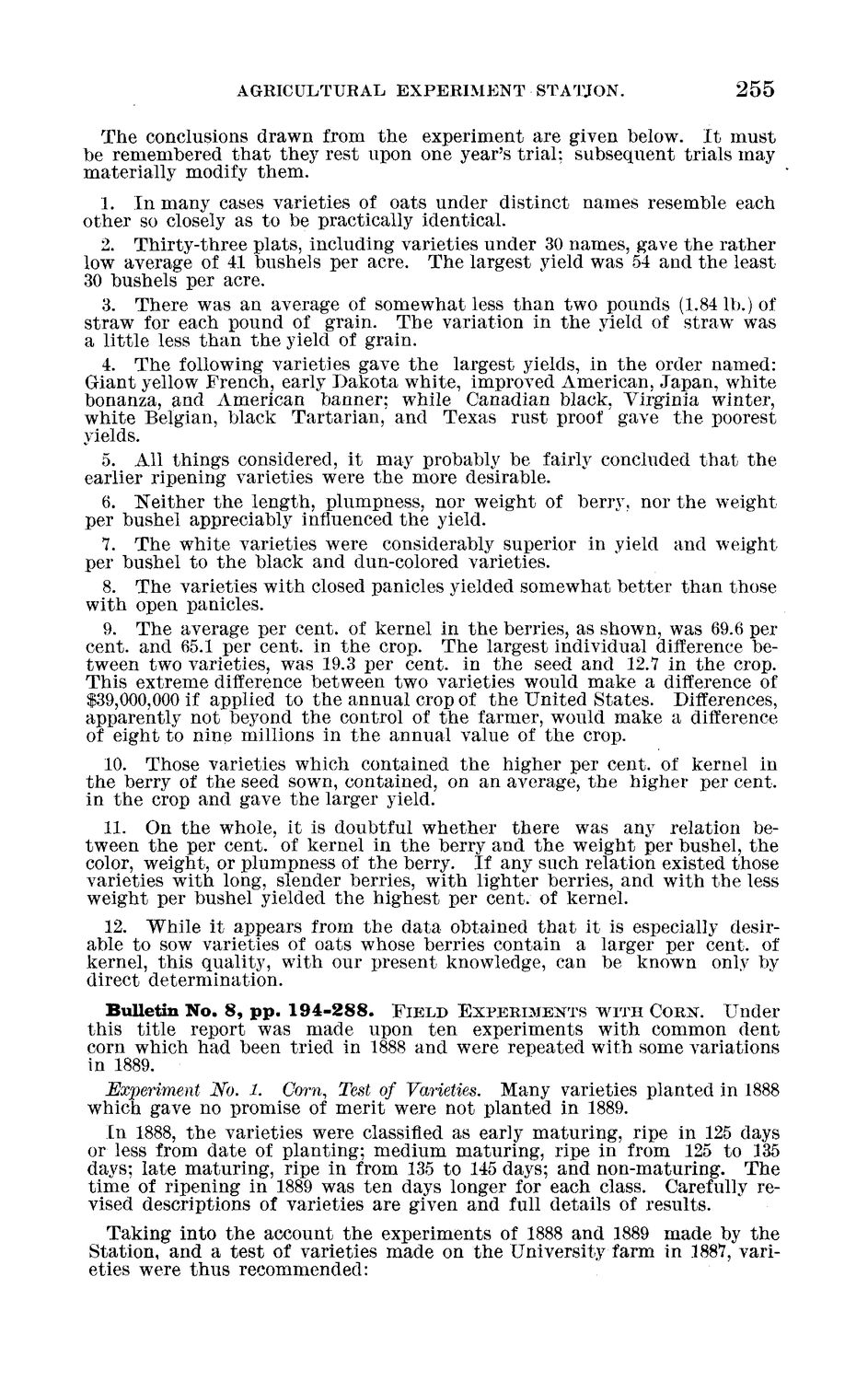| |
| |
Caption: Board of Trustees Minutes - 1890
This is a reduced-resolution page image for fast online browsing.

EXTRACTED TEXT FROM PAGE:
AGRICULTURAL EXPERIMENT-STATION. 255 The conclusions drawn from the experiment are given below. I t must be remembered t h a t they rest upon one year's trial: subsequent trials may materially modify them. 1. I n many cases varieties of oats under distinct names resemble each other so closely as to be practically identical. 2. Thirty-three plats, including varieties under 30 names, gave the rather low average of 41 bushels per acre. The largest yield was 54 and the least 30 bushels per acre. 3. There was an average of somewhat less than two pounds (1.84 lb.) of straw for each pound of grain. The variation in the yield of straw was a little less than t h e yield of grain. 4. The following varieties gave t h e largest yields, in the order named: Giant yellow French, early Dakota white, improved American, Japan, white bonanza, and American banner; while Canadian black, Virginia winter, white Belgian, black Tartarian, and Texas rust proof gave the poorest yields. 5. All things considered, it may probably be fairly concluded t h a t the earlier ripening varieties were t h e more desirable. 6. Neither the length, plumpness, nor weight of berry, nor the weight per bushel appreciably influenced the yield. 7. The white varieties were considerably superior in yield and weight per bushel to the black and dun-colored varieties. 8. The varieties with closed panicles yielded somewhat better than those with open panicles. 9. The average per cent, of kernel in the berries, as shown, was 69.6 per cent, and 65.1 per cent, in the crop. The largest individual difference between two varieties, was 19.3 per cent, in t h e seed and 12.1 in t h e crop. This extreme difference between two varieties would make a difference of $39,000,000 if applied to the annual crop of the United States. Differences, apparently not beyond the control of t h e farmer, would make a difference of eight to nine millions in t h e annual value of the crop. 10. Those varieties which contained t h e higher per cent, of kernel in the berry of the seed sown, contained, on an average, the higher per cent, in the crop and gave the larger yield. 11. On the whole, it is doubtful whether there was any relation between the per cent, of kernel in the berry and t h e weight per bushel, the color, weight, or plumpness of the berry. If any such relation existed those varieties with long, slender berries, with lighter berries, and with the less weight per bushel yielded the highest per cent, of kernel. 12. While it appears from t h e data obtained t h a t it is especially desirable to sow varieties of oats whose berries contain a larger per cent, of kernel, this quality, with our present knowledge, can be known only by direct determination. Bulletin No, 8, pp. 1 9 4 - 2 8 8 . F I E L D E X P E R I M E N T S WITH CORN. Under this title report was made upon ten experiments with common dent corn which had been tried in 1888 and were repeated with some variations in 1889. Experiment No. 1. Corn, Test of Varieties. Many varieties planted in 1888 which gave no promise of merit were not planted in 1889. In 1888, t h e varieties were classified as early maturing, ripe in 125 days or less from date of planting; medium maturing, ripe in from 125 to 135 days; late maturing, ripe in from 135 to 145 days; and non-maturing. The time of ripening in 1889 was ten days longer for each class. Carefully revised descriptions of varieties are given and full details of results. Taking into the account t h e experiments of 1888 and 1889 made by the Station, and a test of varieties made on the University farm in 1887, varieties were thus recommended:
| |